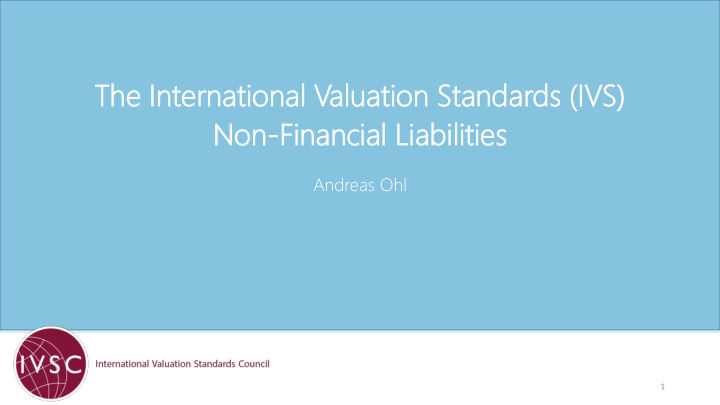



Th The In e Internatio ernational nal Valuatio luation n Standar andards ds (IVS) S) No Non-Financial inancial Lia iabi biliti lities es Andreas Ohl 1
IVSC’s Mission & Vision… The IVSC is the global not-for-profit body responsible for setting the International Valuation Standards (IVS) and for developing the valuation profession, worldwide. Working with our partners, our goal is to build trust in valuation by establishing a globally consistent, high-quality valuation standard and by supporting the growth of the valuation profession. In achieving this, the IVSC aims to support business, strengthen financial markets and protect the public interest. 2 www.ivsc.org
93 member organis isatio ions headquartered in 57 countrie ies
Professionals applying IV IVS S in in 103 countri ries
IVSC Current Projects • Exposure draft to amend IVS 2017 • Discount rates • Early stage companies • Inventory valuation • Non-Financial liabilities Coming soon a financial instruments board 5
Why Non-Financial Liabilities • Most valuation guidance focuses on: • Assets • Entities • Securities • Most think of liability value thru the eyes of the holder of an asset • This works for better for Financial Liabilities 6
Valuation Challenges • Often there is no corresponding asset • Environmental liabilities • Asymmetry is common • Warranty • Cannot or do not trade • Litigation • Possible outcomes often not normally distributed • Payment tied to a regulatory event 7
Common Non-Financial Liabilities • Litigation • Environmental • Indemnifications • Warranties • Deferred revenue • Asset retirement obligations • Contingent consideration Line between FL and Non-FL can be blury (e.g. guarantees) 8
Characteristics of Non-Financial Liabilities • Cash flows are often not contractual • Credit risk, term and duration are not the primary value drivers • Market inputs not readily available • Highly illiquid • No corresponding asset • Counterparties are often widely dispersed • Often includes a significant performance obligation 9
What are the Issues? • When do markets trump models? • When is asset/liability symmetry relevant? • What are the dynamics of the hypothetical market? • Arbitrage in a market with wide bid/ask spreads • How capture risk? • In cash flows • In discount rate • In some other input 10
Markets vs Models • Generally operating in the world of models • IVS requires models to be calibrated to markets • IVS requires considering multiple valuation approaches • Must capture non-performance risk 11
Which Models? • Cost, market and income approaches may apply • Income approaches are often applied • Two common models: • Probability weighted scenarios • Option based • Availability of good data for inputs is critical in selecting a model 12
Key Inputs • Timing and amount of costs to settle, fulfill or transfer the obligation • Risk margin • Degree of uncertainty • Uniqueness of the risk • Materiality, particularly the existence of fat tails • Skewed distribution • Profit margin How adjust for risk, in the CF or the discount rate? 13
What Comes Next • IVSC will issue and Exposure Draft soon • Appraisal Foundation has issue a paper on Contingent Consideration • New FI Board will tackle FI issues 14
Grazie! 15
16 www.ivsc.org
“Public trust – that’s what I believe the global valuation profession has to strive for. Accounting regulators, stock market regulators, central banks and tax authorities around the world are calling for more consistent global valuation standards and guidelines. Users need to be confident in the robustness and reliability of our valuation opinions, the IVSC is right at the heart of driving this agenda. ” Doug McPhee Global Head of Valuation, KPMG www.ivsc.org
“Valuation consistency and quality throughout the world is one area where investors often face challenges. We’re in the business of investing other peoples’ money responsibly and it is therefore vital that we have access to reliable and consistent valuations carried out by qualified professionals. ” Martin Brühl Chief Investment Officer, Union Investment Real Estate www.ivsc.org
“ We have a huge opportunity to increase the visibility and credibility of the valuation profession. That opportunity centres on adopting common standards; working with credentials that set a higher bar on quality, consistency and transparency; and then committing and holding to that higher bar. ” Leigh Miller Global Leader, Valuation and Business Modelling, EY www.ivsc.org
“Convergence of valuation standards is important as economic globalisation drives the need for alignment. IVS has become the most influential professional valuation standard worldwide and countries should seek convergence, either directly or through existing standards, so that it becomes the benchmark for valuation practice. ” Dr Zhang Guochun Secretary General, China Appraisal Society www.ivsc.org
www.ivsc.org 21
Recommend
More recommend